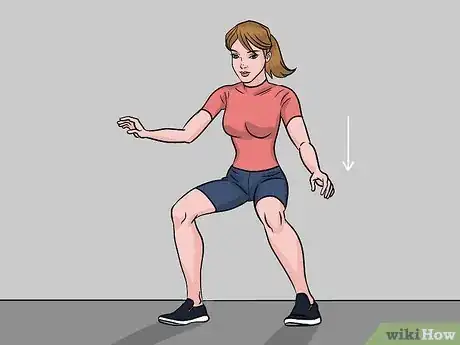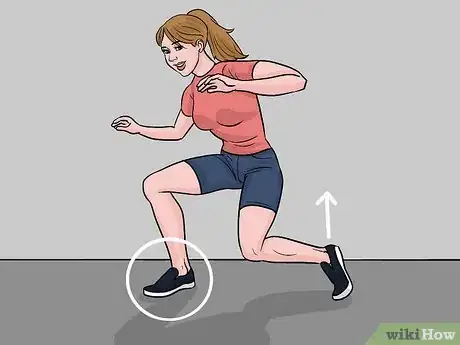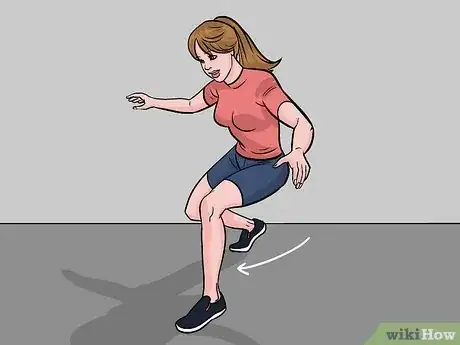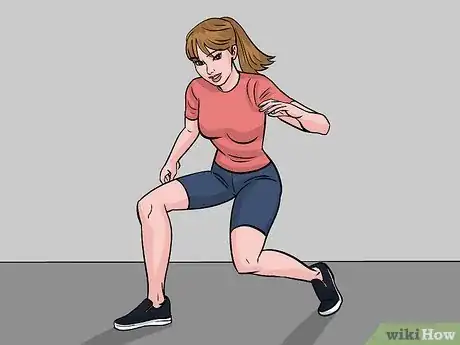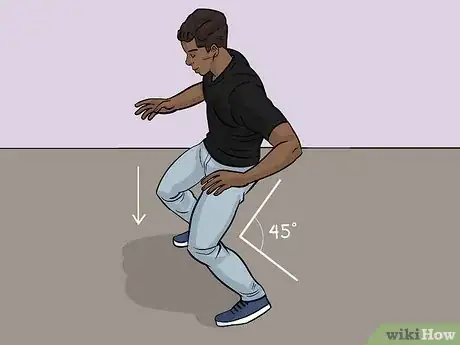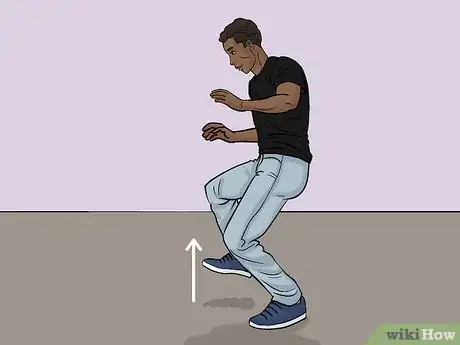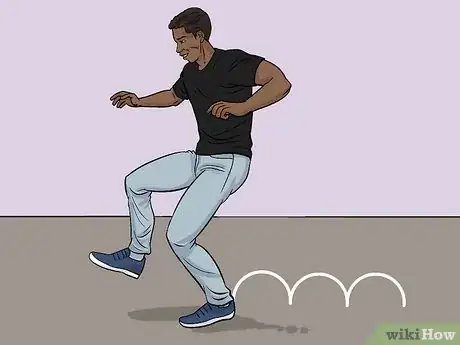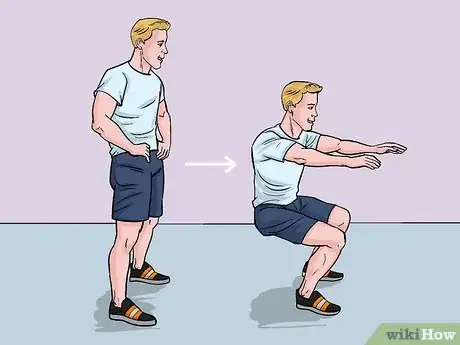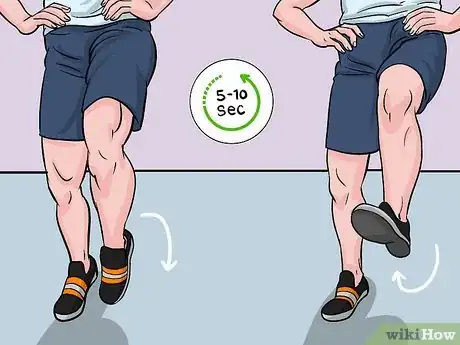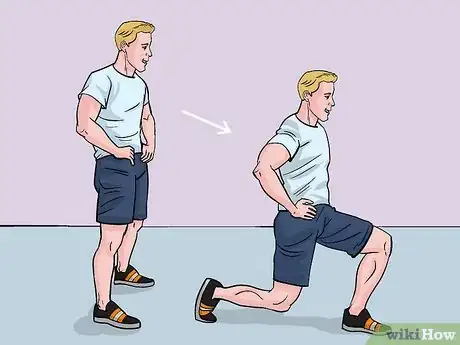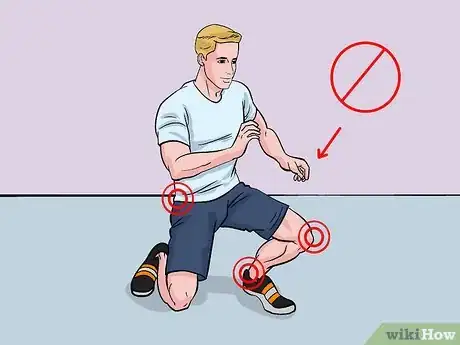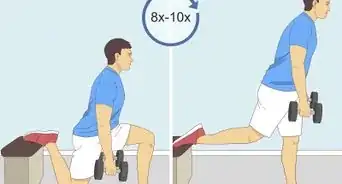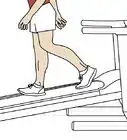This article was co-authored by Dean Theriot. Dean Theriot is a Personal Trainer and the Owner of Timberline Fitness in Houston, Texas. With over 25 years of experience in the fitness industry, Dean specializes in personal, group, and sport-specific training. Dean holds a BS in Exercise Physiology from LSU. Dean combines resistance and cardiovascular training with pilates exercises for comprehensive workouts for his clients. His sport-specific training includes football, basketball, and baseball.
There are 12 references cited in this article, which can be found at the bottom of the page.
This article has been viewed 104,754 times.
The duck walk is an easy bodyweight exercise that's great for working out your glutes and quadriceps. It's also a classic stage movement used by musicians to add some flair to their guitar solos. Whether you're here for a workout or to prepare for a performance, we've got you covered. Check out the steps below to learn how to duck walk during your next workout or music gig.
Steps
Performing the Duck Walk as an Exercise
-
1Lower yourself into a crouch. The most recognizable characteristic of the duck walk is its low position. Start by sinking into a squat, your center of gravity aligned over your heels.[1] Get as deep as you comfortably can. You may want to lightly warm up and stretch your hips, knees and ankles beforehand to make working through the motion easier.[2]
- If you’re doing the duck walk for exercise purposes, a slightly higher stance (thighs about parallel to the ground) will be more muscularly demanding.
-
2Keep your weight on your heels. To aid in stability, keep your entire foot in contact with the ground and rest most of your weight over your heels. This will ensure that you’re taking advantage of the most surface area possible and will allow you to use minor adjustments to keep your weight evenly distributed. Tense the muscles in your legs the whole time you’re in the bottom position—relaxing could cause you to lose tightness and fall over.
- Engage your core by squeezing your abdomen. Don’t allow your torso to lean or turn as you start the walking motion.
Advertisement -
3Balance your weight on one foot. At the bottom of the squat, lift one foot off the ground slowly. All of your weight will now be poised over your other foot. Spend a few seconds getting used to maintaining your balance in this posture. While duck walking, you will essentially alternate between single-foot balancing in a low crouch.[3]
- Ankle flexibility is important at this stage because it makes balancing on one foot much easier.
-
4Take a step forward. While balancing on your first foot, bring your opposite foot forward and across your body and set it down in front. Then, shift your weight to your front foot, pushing your back knee forward as you do so. Get centered over your front foot to stay upright.[4]
- Hold your arms in front of your body or out to the sides to help you balance.
-
5Get into a rhythm. Now repeat the stepping action using both legs to start walking. Make sure you shift your balance carefully when transitioning from one foot to the other. Duck walking can be quite strenuous at first, as you’re basically holding yourself in a one-leg squat, but it will gradually become easier with practice.[5]
- Try to cover 10-12 feet at a time by duck walking, or aim for a specific number of steps to complete. Increase your steps or distance over time as you get better.
- After every few steps, stand up and give your leg muscles a chance to recover.
Performing the Duck Walk on the Stage
-
1Squat down at a slight angle. Bend your knees to about a 45 degree angle and lower your weight at your hips. Your head should come to a stop at around chest level or slightly lower. Unlike the exercise-focused variation, the version of the duck walk designed for use on stage keeps you in a more vertical position so that you can continue playing or singing.[6]
- Chuck Berry did his signature duck walk quite low. This made it look impressive and memorable, and also a bit humorous. Angus Young from AC/DC, another notable representative of the move, tended to stay in an upright stance, making it look more like a game of hopscotch.[7]
-
2Stand on one foot. Lift your non-dominant leg and extend it straight out in front of you at an angle with the floor. Keep your dominant leg planted for better stability and balance. Once again, your entire foot should be flat on the floor, with more of your weight hovering over your heel.
- Since the “rock and roll” style duck walk is done on one leg, it can be harder to balance and may tire you out faster.
- Try switching up which leg you use from time to time until you can do it on both sides.
-
3Use small hops to travel forward. From this skewed-leg position, take a small hop off your grounded foot. You don’t need to try to jump too high or far: only move forward a couple inches at a time. Hop along in this manner on one foot to accentuate your performance. Let your extended leg hover just over the ground, or touch down with your heel if you need to correct your balance.[8]
- Make your hops small and controlled. Your head shouldn’t bob up and down too much while you’re traveling forward.
- If you want your duck walk to look more like Chuck Berry’s, flare your non-hopping leg up and down a little with each hop.[9]
-
4Focus on your upper body. Straighten your back and keep your chest up. This will allow you to create enough room to play the guitar, saxophone or another instrument while duck walking. A more elevated body position also won’t require you to use your hands to help preserve your balance, freeing them up for groovy solos.
- Practice while holding or actually playing your instrument to see if you can pull off the two tasks simultaneously.
Limbering Up for the Duck Walk
-
1Do a few light squats. Get your muscles ready and your blood circulating before you attempt to duck walk. With your heels on the floor, squat down until your thighs are parallel with the ground. Hold for one second, then push yourself back up to a standing position. Perform 10-15 squats to make sure you’re adequately warmed up before you get mobile.[10]
- You’ll find it easier to move around and get into challenging positions after your muscles have been primed.
- An energetic stage show can make a good substitute for a thorough warm up.
-
2Flex your ankles. Lift one foot off the ground. Point your toes and hold for 5-10 seconds. Then, pull your toes back toward your shin and flex your foot, again holding for several seconds. Repeat this exercise a few times with each foot to help loosen up your ankles and prepare them to support your weight.[11]
- You can also stretch your ankles by getting down into a full squat and leaning over the balls of your feet while making sure your heels remain on the floor.
-
3Stretch out your hips and legs. Do a couple minutes of static stretching following your warm up. Exercises like forward lunges, standing quadriceps and hamstring stretches and hip circles will temporarily increase your flexibility so that you can effectively move in a deep crouch. Stretching is critical for elongating and promoting blood flow to the tendons and ligaments, which can easily be torn or strained by awkward, low-leverage movements like the duck walk.[12]
- Don’t neglect to stretch if you feel stiff, as it can greatly reduce your chances of getting hurt. The only thing you want to tear up is the music.
-
4Be careful. Duck walking can be fun and entertaining in the right setting, but it’s not for everyone. Avoid any movement that feels uncomfortable or places your joints in unstable positions, especially if you’ve suffered an injury to any part of your hips, knees, or ankles in the past. Even the young and uninjured should be aware of the potential risks of duck walking, as it’s such an unusual form of locomotion.[13]
- Those with arthritis or mobility issues should think twice before playing around with squatting movements.
- If you experience pain at any point while duck walking, stop immediately.
Expert Q&A
Did you know you can get expert answers for this article?
Unlock expert answers by supporting wikiHow
-
QuestionHow do you do the duck walk exercise?
 Dean TheriotDean Theriot is a Personal Trainer and the Owner of Timberline Fitness in Houston, Texas. With over 25 years of experience in the fitness industry, Dean specializes in personal, group, and sport-specific training. Dean holds a BS in Exercise Physiology from LSU. Dean combines resistance and cardiovascular training with pilates exercises for comprehensive workouts for his clients. His sport-specific training includes football, basketball, and baseball.
Dean TheriotDean Theriot is a Personal Trainer and the Owner of Timberline Fitness in Houston, Texas. With over 25 years of experience in the fitness industry, Dean specializes in personal, group, and sport-specific training. Dean holds a BS in Exercise Physiology from LSU. Dean combines resistance and cardiovascular training with pilates exercises for comprehensive workouts for his clients. His sport-specific training includes football, basketball, and baseball.
Personal Trainer
-
QuestionCan this be used for pretending to be Gollum from Lord of the Rings?
 Community AnswerYes, if you would like to pretend to be Gollum, go for it! The duck walk can be very fun and entertaining, but remember- avoid any uncomfortable movements and if it begins to hurt, take a break!
Community AnswerYes, if you would like to pretend to be Gollum, go for it! The duck walk can be very fun and entertaining, but remember- avoid any uncomfortable movements and if it begins to hurt, take a break! -
QuestionI thought all I needed to do was press down. Am I incorrect?
 Community AnswerJust crouch or sit down; the pressure must be kept on the legs. Walk, keeping your hands around your neck.
Community AnswerJust crouch or sit down; the pressure must be kept on the legs. Walk, keeping your hands around your neck.
Warnings
- Don't force a deep squat or attempt to go lower than you can comfortably. This could result in a minor injury.⧼thumbs_response⧽
References
- ↑ Dean Theriot. Personal Trainer. Expert Interview. 22 February 2021.
- ↑ https://www.youtube.com/watch?v=78fBPxkCfao
- ↑ http://www.yogajournal.com/article/practice-section/hints-for-balancing/
- ↑ https://www.youtube.com/watch?v=78fBPxkCfao
- ↑ https://www.youtube.com/watch?v=14BjRxE7f1o
- ↑ http://www.history-of-rock.com/berrytwo.htm
- ↑ https://www.youtube.com/watch?v=JdfyrOlOmeQ
- ↑ https://www.youtube.com/watch?v=Cm8ktxzaumg
- ↑ https://www.youtube.com/watch?v=T3rG73VOqyo
- ↑ http://www.bodybuilding.com/content/what-all-squatters-knee-d-to-know.html
- ↑ https://breakingmuscle.com/mobility-recovery/a-weak-foundation-how-to-screen-your-ankles-improve-performance-and-decrease-injur
- ↑ https://wellness.ucr.edu/Stretches%20for%20Lower%20and%20Upper%20Body.pdf
- ↑ http://www.webmd.com/fitness-exercise/features/when-not-to-exercise#1
